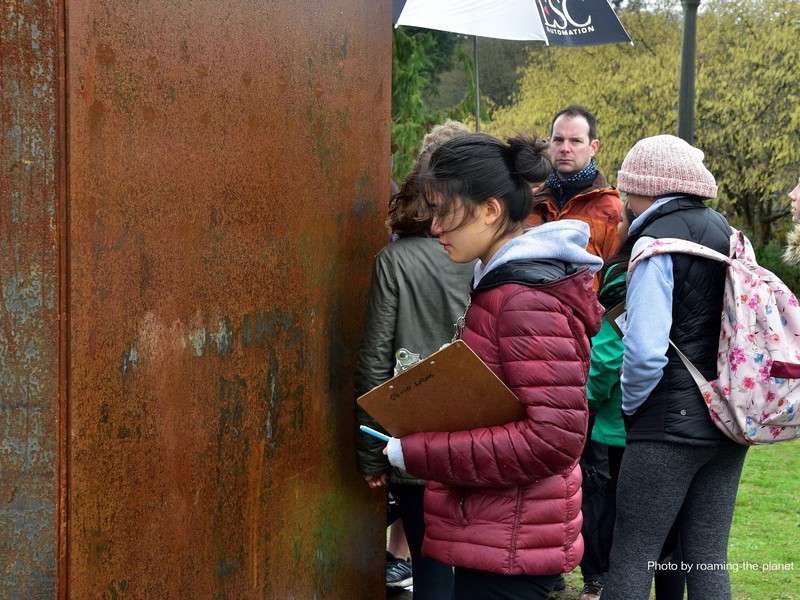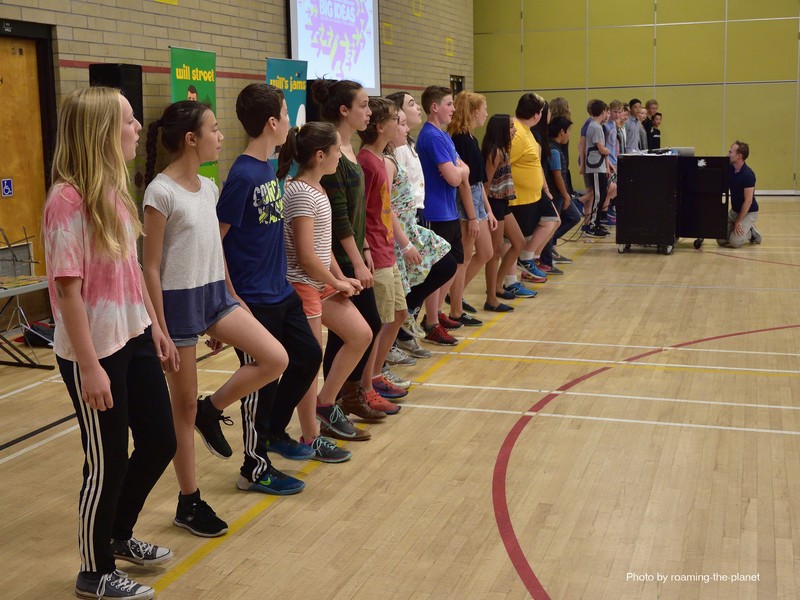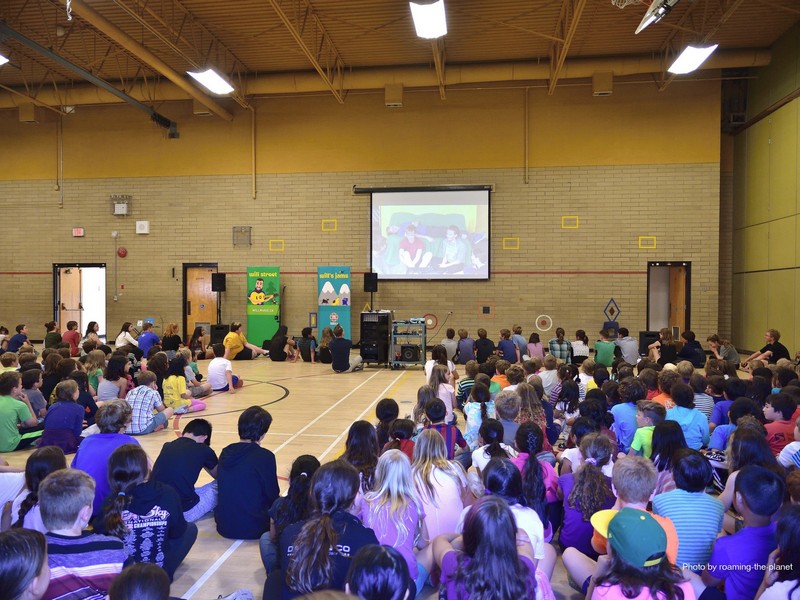École Bilingue (Grade 7): Is Home away from Home?
Arts Education, Language Arts, Mathematics, Science, Social Studies
School: Ecole Bilingue Elementary
Teacher: Olivier Salvas
Artist Collaborators: Julie Lynn Mortensen
Class: Grade 7
Overview
The world is filled with horrible events from the Syrian War to the recent events in Pairs. Here, in Canada, we are very fortunate with our freedom and what we stand for. We are also blinded to the nature and to the history that surround us as we stay focused to what the mankind has created such as borders, roads, ploitics or buildings. As many people in the world is forced into finding new homes or to escape their country, we are hoping to give the students a moment where they have the possibility to reflect and to explore the environment that surrounds them. The purpose of this project is to open the students’ minds to find various ways in which they can describe their home if the manmade borders did not exist but only its people and its nature. Students are offered different exploration avenues to describe their environment through the five senses – touch, taste, smell, hearing, and sight, bearing in mind the guiding question. The students then decided the artistic avenue to take and the elements of answers to present living installations to reflect what is home.
Connection to the Vancouver Biennale Exhibition
Prior to going to the field trip, the teachers asked the kids to draw what a typical home was to them. They asked the kids to make their drawing as realistic as possible and to bring their home drawing to the field trip. Then the class went through a journey with their field trip. The started their day at Home by the Sea by Louis Fernando Perlaes. The artist describes the form, an abstracted house split in two, as “opened in the centre, closed at the sides, a nest of wind and night.” The class liked that the art piece has a concrete representation of what a home is and does not have a typical shape as it is split in two, a bit like two sides of the coin. This installation had a strong representation of what the borders that we create in our mind are. Its shape is iconic, its material is bold, and the pathway in the middle guides the viewer into a specific direction to go through, a bit like a metaphor of a narrow way of thinking about what a house should be like. At this location, the teachers asked the kids to reflect on what their house looks like. How was it different from theirs? They recorded their thinking and were also asked to draw the installation by Perlaes next to the drawing they had previously done.
The class then went on a venture in the West end of Vancouver. They went through the streets to see different kinds of homes. They also went through Stanley Park to explore the nature centre to see different kinds of habitats, as well as the First Nations totem poles to learn about the lives of First Nations communities.
The day ended with the second Biennale installation 217.5 Arc x 13 by Bernar Venet. They were particularly drawn to this installation because of the quote from its description that says “Venet employs mathematical manipulations of this industrial material to explore the interconnected relationships between nature, humanity and the universe.” These three aspects were explored by the students through the five senses by posing the following questions:
- Nature: How can we describe our environment through the natural elements that surround us?
- Humanity: Who lives here and why? What are their stories?
- Universe: How does our location in the world have an impact on our daily lives?
The class was also drawn to this installation because of its shape and location. The way that the installation blends in with the nature that surrounds it has a profound impact on its meaning.
BIG IDEAS
Social Studies: Geographic conditions shaped the emergence of civilizations.
Science: The theory of evolution by natural selection provides an explanation for the diversity and survival of living things.
Language Arts: Exploring text and story helps us understand ourselves and make connections to others and to the world.
Mathematics: Geometry and measurement empower us to make meaning of the world. Data enable us to draw conclusions and make predictions in an unstable world.
Arts Education: Through art making, one’s sense of identity and community continually evolves. Dance, drama, music, and visual arts are each unique languages for creating and communicating.
Guiding Questions
How can you describe your home without the man made borders?
Can home be away from home?
Cross Curricular Access
BIG IDEA: Geographic conditions shaped the emergence of civilizations.
- Understanding of the needs of living things and organisms (Science)
- Analyzing the landscape, regions, and shapes of homes (Math)
- Creating artistic works collaboratively and as an individual using ideas inspired by imagination, inquiry, experimentation, and purposeful play. (Drama)
- Understanding how the extreme environments played a role in the location of the first civilizations (Social Studies/science)
- Understanding why first nations and first civilizations have established themselves in a specific environment. (Social Studies)
- Use writing and design processes to plan, develop, and create engaging and meaningful informational texts for a variety of purposes and audiences through journal writing and technology. (Language Arts)
BIG IDEA: Through art making, one’s sense of identity and community continually evolves.
- First Nations tells legends that have an impact on our culture (Social Studies)
- Cultural references, spiritual beliefs and common interests have shaped who we are (Social studies)
- Consider social, ethical, and environmental implications of the findings from their own and others’ investigations (Science).
- Experience, document, choreograph, perform and share creative works in a variety of ways (Arts)
- Read tales, novels, poetry on the theme of identity and environment to understand another point of view (Language Arts).
- Questioned the community and analyzed the data (Math).
- Wrote poetry, and narrative stories to explain what a home is (Language arts/Arts)
- To create dances to represent our environment (Arts Education).
Learning Process/Inquiry Challenges
The project began with a three step journey: to have the students explore their physical needs in an environment, to learn about the interaction of humans in their environments and to consider various perspectives on ‘homes’ through personal stories. Through these steps, students learned to develop their own point of view in reference to the guiding questions.
In order to explore their physical needs, students looked at various living things to see what is common amongst them. Students inquired into the following questions: What makes a living thing ‘living’? What living things can we observe in our community? They completed an activity first by going to Stanley Park on the day of exploration of the two installations and later by exploring the park by their school. Students recorded what they observed once back in class and they created a diagram to organize the living things and their habitats. The class then learned to classify living things by learning about the animal kingdom, and looked at different animal environments. Students were then asked to show how living things adapt to their environment by making a drama video that was a mixture of fiction and reality using emotions.
For the second step, ‘learning about the interaction of humans in their environments,’ the class explored the following question: How does where we live influence how we live? The class began by exploring the canadian laws, culture and values. They also compared these aspects to other places within Canada and in other countries. The students made graphs and hosted debate activities to explore different perspectives. The teachers delved into local and international issues with the class, along with the current issue of refugees and the political climate.
In order to examine different perspectives of ‘homes,’ students were asked to read a novel on the theme of refugees, immigration and home so that they could discuss the point of view of the characters with other classmates in their reading circles. Students also had the opportunity to do a painting of one char acter and a representation of his/her environment as well as a spoken word piece to talk about the challenges that immigrants and refugees might be facing in their new country.
Student Creation
The students created a happening, a multi-media visual representation that included different forms of artistic expression.
The students created a blog – http://div2biennale2016.edublogs.org responding to the guiding questions.
The students wrote a play about the guiding questions.



